Computer Information System Implementation Report Analysis and Review
VerifiedAdded on 2020/05/28
|7
|1454
|113
Report
AI Summary
This report provides a comprehensive analysis of a proposed enterprise information system, designed to upgrade an outdated and inefficient existing system. The new system leverages cloud-based data management for enhanced business operations, including data analytics, market analysis, and automated staff attendance tracking. It details the types of data involved, such as employee and business data, and emphasizes the importance of data quality through validation processes. The report compares the old and new systems, highlighting the limitations of the old system's physical storage and manual data management against the new system's unlimited cloud storage and automated processes. Furthermore, it discusses the impact of information technology on business organizations, showcasing examples of successful implementations and the benefits of increased system efficiency and reduced costs. The report concludes by emphasizing the significant role of information systems in improving various aspects of business, such as analytics, data management, and market prediction.
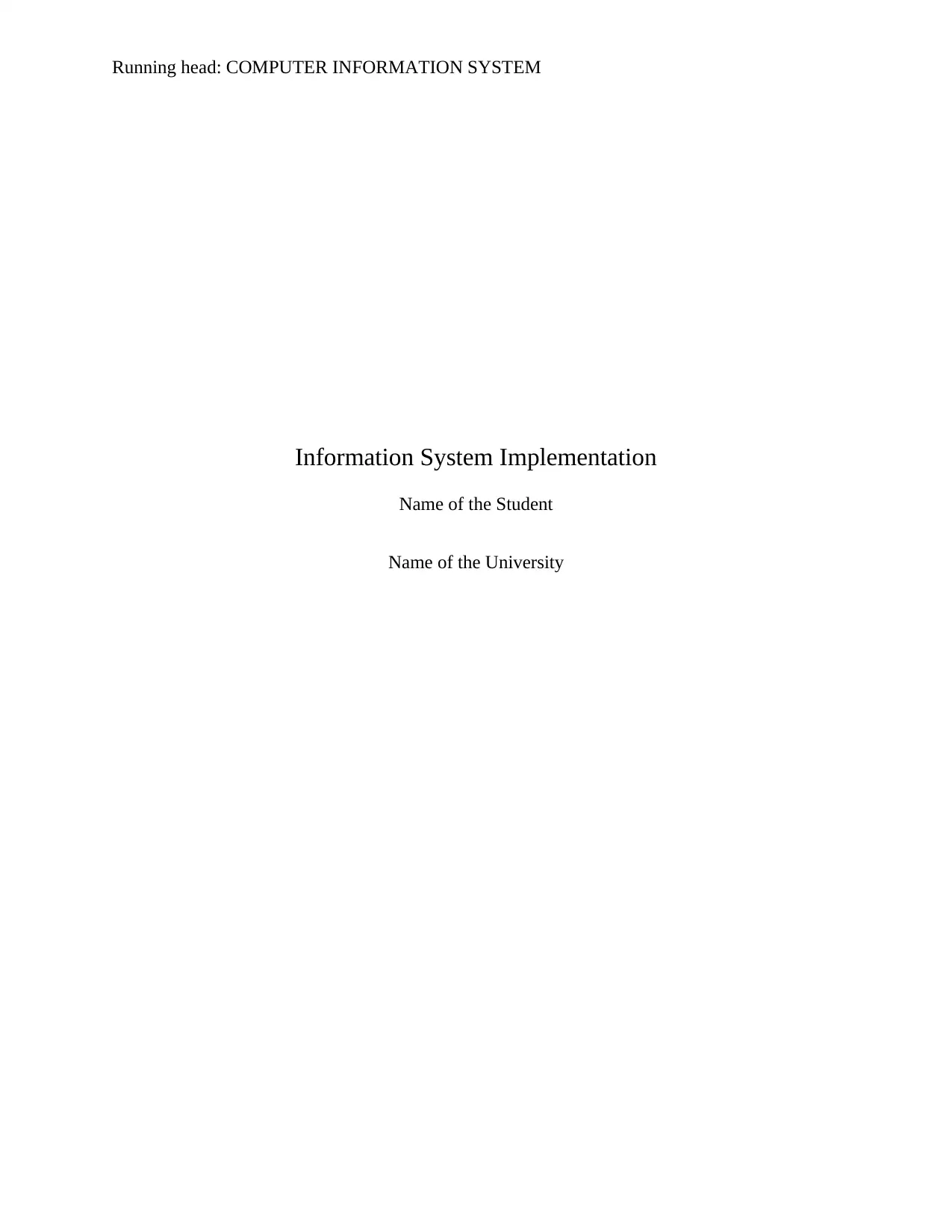
Running head: COMPUTER INFORMATION SYSTEM
Information System Implementation
Name of the Student
Name of the University
Information System Implementation
Name of the Student
Name of the University
Paraphrase This Document
Need a fresh take? Get an instant paraphrase of this document with our AI Paraphraser
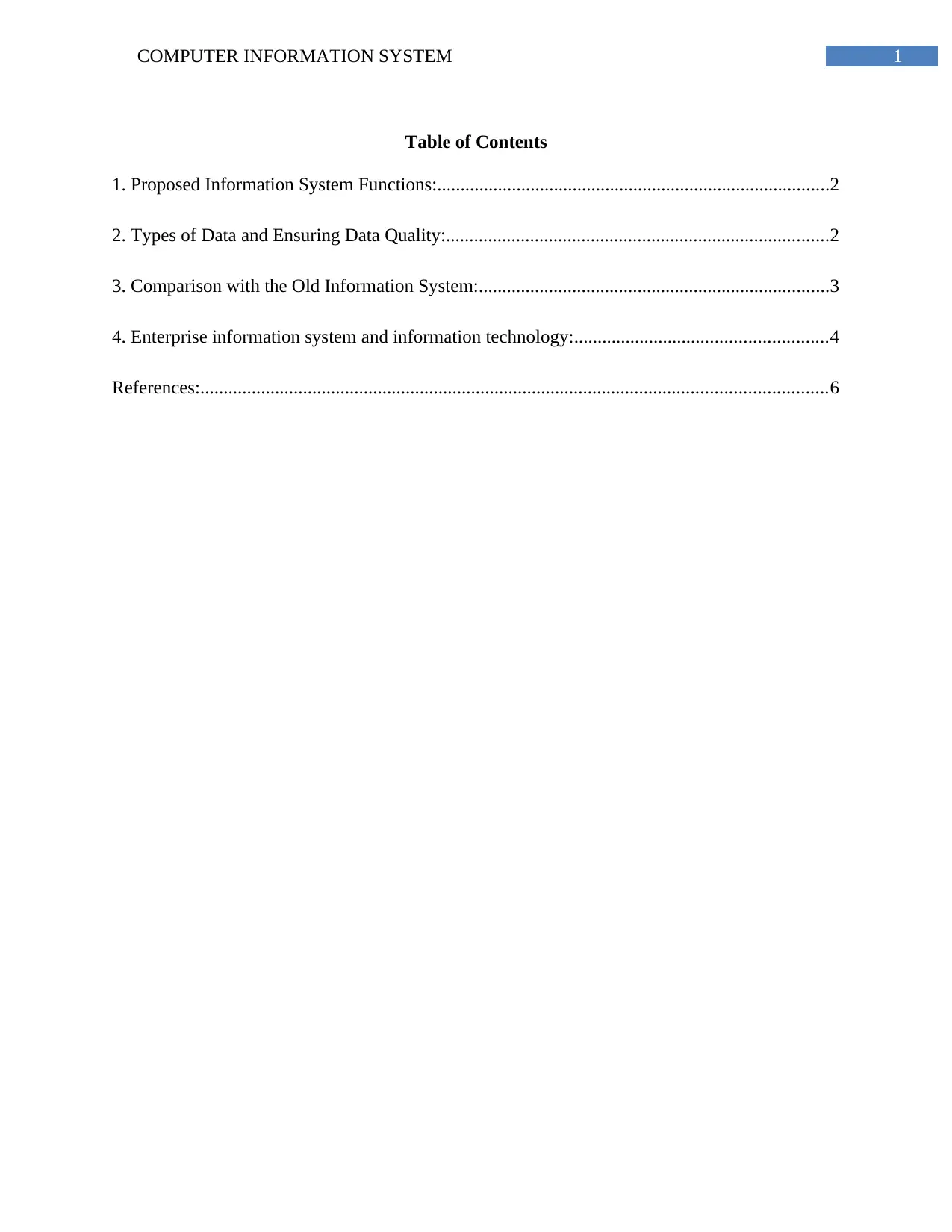
1COMPUTER INFORMATION SYSTEM
Table of Contents
1. Proposed Information System Functions:....................................................................................2
2. Types of Data and Ensuring Data Quality:..................................................................................2
3. Comparison with the Old Information System:...........................................................................3
4. Enterprise information system and information technology:......................................................4
References:......................................................................................................................................6
Table of Contents
1. Proposed Information System Functions:....................................................................................2
2. Types of Data and Ensuring Data Quality:..................................................................................2
3. Comparison with the Old Information System:...........................................................................3
4. Enterprise information system and information technology:......................................................4
References:......................................................................................................................................6
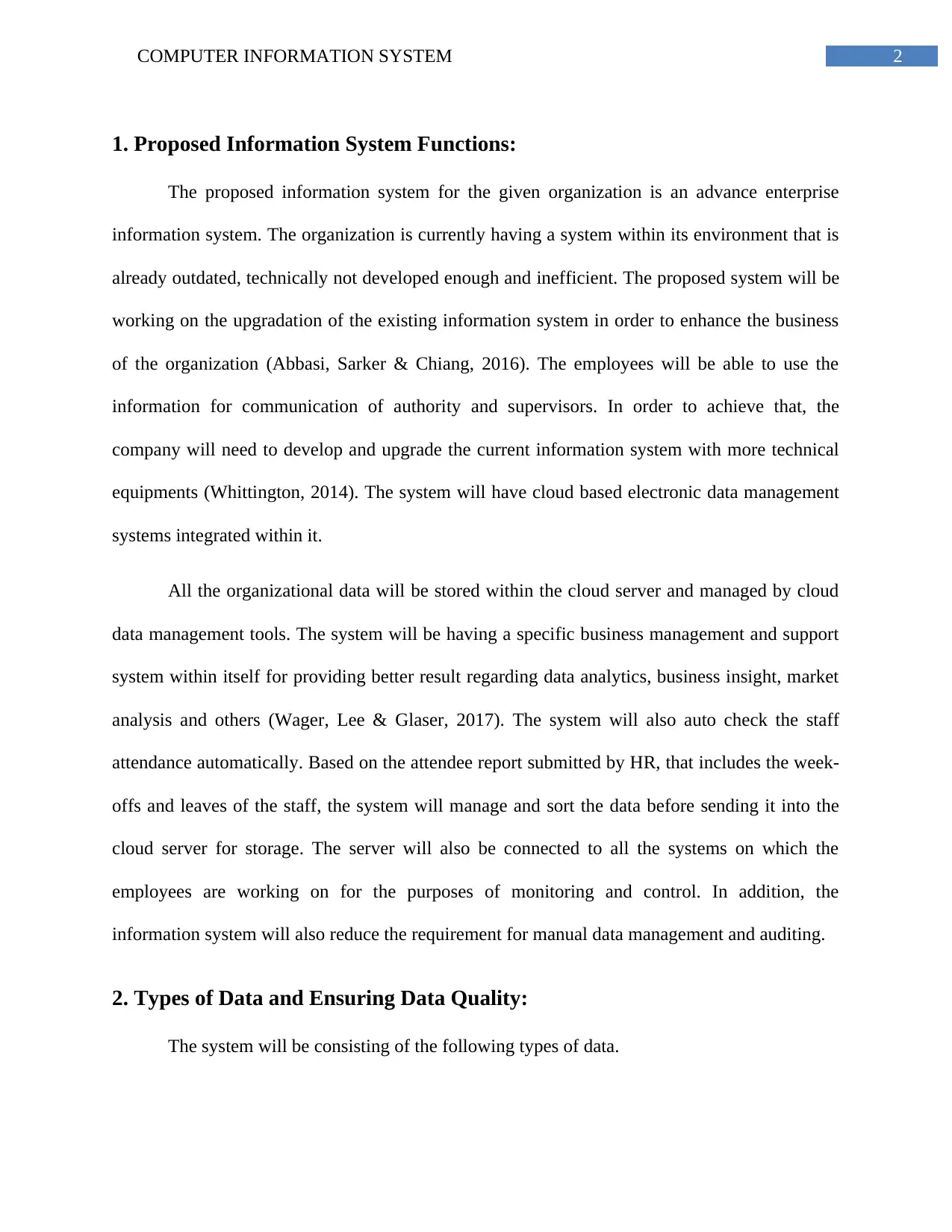
2COMPUTER INFORMATION SYSTEM
1. Proposed Information System Functions:
The proposed information system for the given organization is an advance enterprise
information system. The organization is currently having a system within its environment that is
already outdated, technically not developed enough and inefficient. The proposed system will be
working on the upgradation of the existing information system in order to enhance the business
of the organization (Abbasi, Sarker & Chiang, 2016). The employees will be able to use the
information for communication of authority and supervisors. In order to achieve that, the
company will need to develop and upgrade the current information system with more technical
equipments (Whittington, 2014). The system will have cloud based electronic data management
systems integrated within it.
All the organizational data will be stored within the cloud server and managed by cloud
data management tools. The system will be having a specific business management and support
system within itself for providing better result regarding data analytics, business insight, market
analysis and others (Wager, Lee & Glaser, 2017). The system will also auto check the staff
attendance automatically. Based on the attendee report submitted by HR, that includes the week-
offs and leaves of the staff, the system will manage and sort the data before sending it into the
cloud server for storage. The server will also be connected to all the systems on which the
employees are working on for the purposes of monitoring and control. In addition, the
information system will also reduce the requirement for manual data management and auditing.
2. Types of Data and Ensuring Data Quality:
The system will be consisting of the following types of data.
1. Proposed Information System Functions:
The proposed information system for the given organization is an advance enterprise
information system. The organization is currently having a system within its environment that is
already outdated, technically not developed enough and inefficient. The proposed system will be
working on the upgradation of the existing information system in order to enhance the business
of the organization (Abbasi, Sarker & Chiang, 2016). The employees will be able to use the
information for communication of authority and supervisors. In order to achieve that, the
company will need to develop and upgrade the current information system with more technical
equipments (Whittington, 2014). The system will have cloud based electronic data management
systems integrated within it.
All the organizational data will be stored within the cloud server and managed by cloud
data management tools. The system will be having a specific business management and support
system within itself for providing better result regarding data analytics, business insight, market
analysis and others (Wager, Lee & Glaser, 2017). The system will also auto check the staff
attendance automatically. Based on the attendee report submitted by HR, that includes the week-
offs and leaves of the staff, the system will manage and sort the data before sending it into the
cloud server for storage. The server will also be connected to all the systems on which the
employees are working on for the purposes of monitoring and control. In addition, the
information system will also reduce the requirement for manual data management and auditing.
2. Types of Data and Ensuring Data Quality:
The system will be consisting of the following types of data.
⊘ This is a preview!⊘
Do you want full access?
Subscribe today to unlock all pages.

Trusted by 1+ million students worldwide
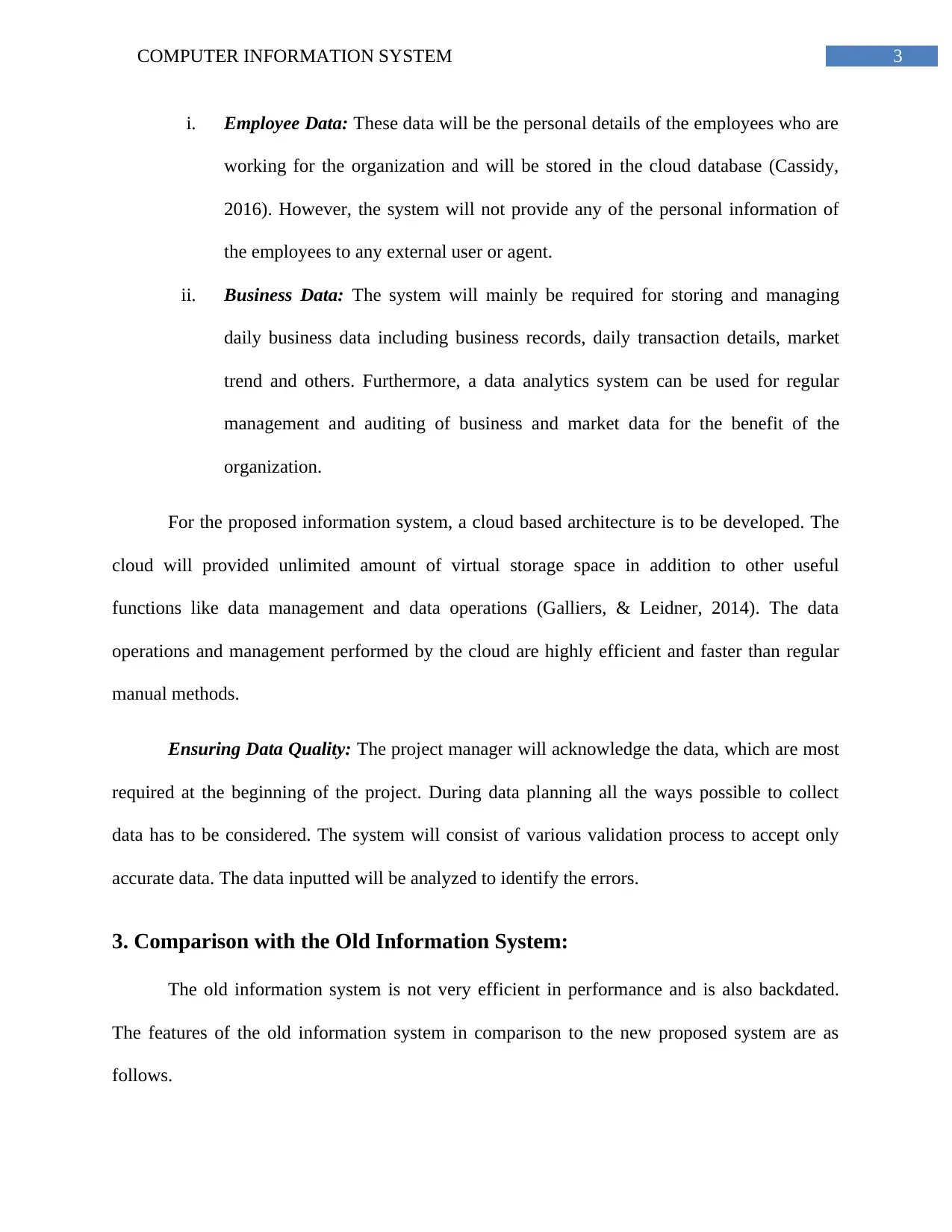
3COMPUTER INFORMATION SYSTEM
i. Employee Data: These data will be the personal details of the employees who are
working for the organization and will be stored in the cloud database (Cassidy,
2016). However, the system will not provide any of the personal information of
the employees to any external user or agent.
ii. Business Data: The system will mainly be required for storing and managing
daily business data including business records, daily transaction details, market
trend and others. Furthermore, a data analytics system can be used for regular
management and auditing of business and market data for the benefit of the
organization.
For the proposed information system, a cloud based architecture is to be developed. The
cloud will provided unlimited amount of virtual storage space in addition to other useful
functions like data management and data operations (Galliers, & Leidner, 2014). The data
operations and management performed by the cloud are highly efficient and faster than regular
manual methods.
Ensuring Data Quality: The project manager will acknowledge the data, which are most
required at the beginning of the project. During data planning all the ways possible to collect
data has to be considered. The system will consist of various validation process to accept only
accurate data. The data inputted will be analyzed to identify the errors.
3. Comparison with the Old Information System:
The old information system is not very efficient in performance and is also backdated.
The features of the old information system in comparison to the new proposed system are as
follows.
i. Employee Data: These data will be the personal details of the employees who are
working for the organization and will be stored in the cloud database (Cassidy,
2016). However, the system will not provide any of the personal information of
the employees to any external user or agent.
ii. Business Data: The system will mainly be required for storing and managing
daily business data including business records, daily transaction details, market
trend and others. Furthermore, a data analytics system can be used for regular
management and auditing of business and market data for the benefit of the
organization.
For the proposed information system, a cloud based architecture is to be developed. The
cloud will provided unlimited amount of virtual storage space in addition to other useful
functions like data management and data operations (Galliers, & Leidner, 2014). The data
operations and management performed by the cloud are highly efficient and faster than regular
manual methods.
Ensuring Data Quality: The project manager will acknowledge the data, which are most
required at the beginning of the project. During data planning all the ways possible to collect
data has to be considered. The system will consist of various validation process to accept only
accurate data. The data inputted will be analyzed to identify the errors.
3. Comparison with the Old Information System:
The old information system is not very efficient in performance and is also backdated.
The features of the old information system in comparison to the new proposed system are as
follows.
Paraphrase This Document
Need a fresh take? Get an instant paraphrase of this document with our AI Paraphraser
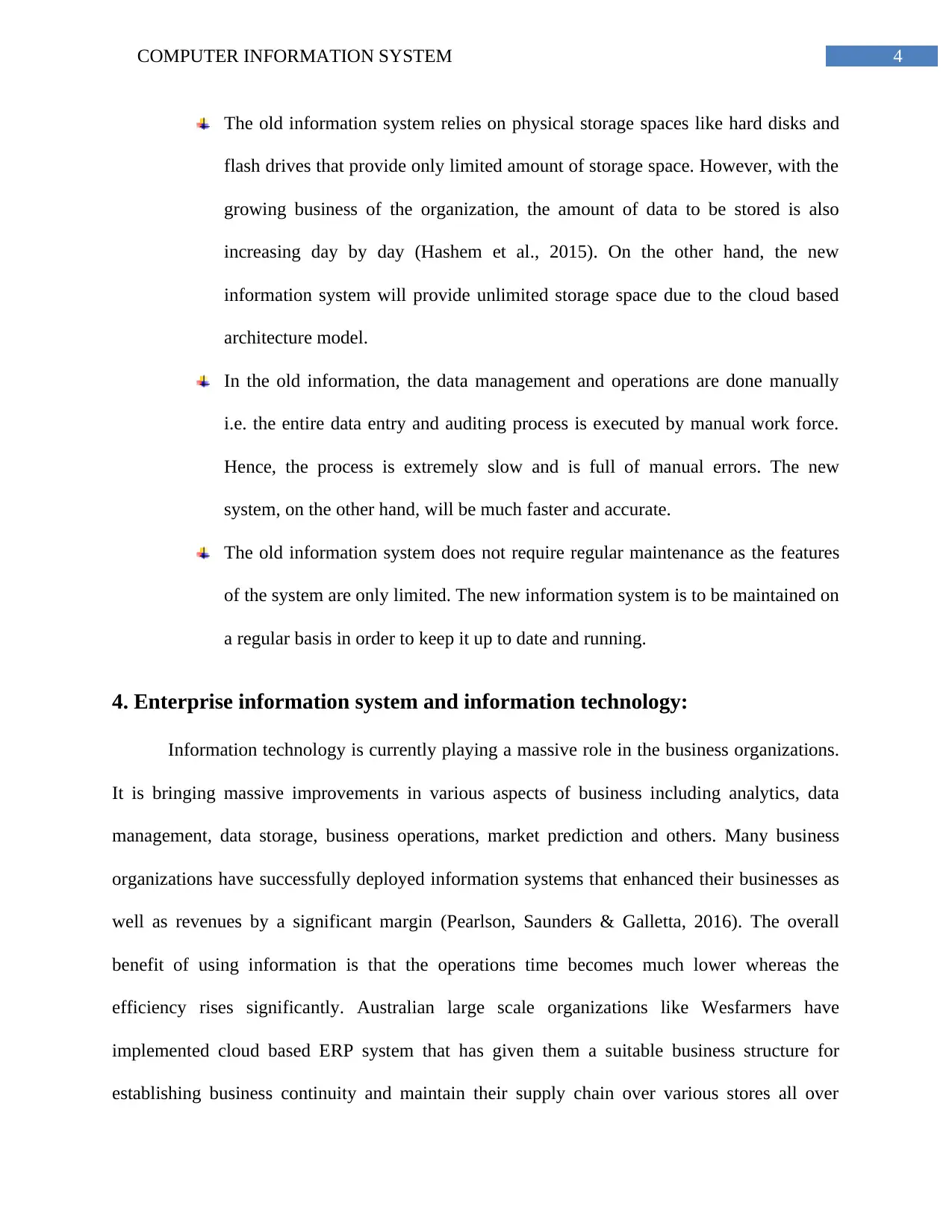
4COMPUTER INFORMATION SYSTEM
The old information system relies on physical storage spaces like hard disks and
flash drives that provide only limited amount of storage space. However, with the
growing business of the organization, the amount of data to be stored is also
increasing day by day (Hashem et al., 2015). On the other hand, the new
information system will provide unlimited storage space due to the cloud based
architecture model.
In the old information, the data management and operations are done manually
i.e. the entire data entry and auditing process is executed by manual work force.
Hence, the process is extremely slow and is full of manual errors. The new
system, on the other hand, will be much faster and accurate.
The old information system does not require regular maintenance as the features
of the system are only limited. The new information system is to be maintained on
a regular basis in order to keep it up to date and running.
4. Enterprise information system and information technology:
Information technology is currently playing a massive role in the business organizations.
It is bringing massive improvements in various aspects of business including analytics, data
management, data storage, business operations, market prediction and others. Many business
organizations have successfully deployed information systems that enhanced their businesses as
well as revenues by a significant margin (Pearlson, Saunders & Galletta, 2016). The overall
benefit of using information is that the operations time becomes much lower whereas the
efficiency rises significantly. Australian large scale organizations like Wesfarmers have
implemented cloud based ERP system that has given them a suitable business structure for
establishing business continuity and maintain their supply chain over various stores all over
The old information system relies on physical storage spaces like hard disks and
flash drives that provide only limited amount of storage space. However, with the
growing business of the organization, the amount of data to be stored is also
increasing day by day (Hashem et al., 2015). On the other hand, the new
information system will provide unlimited storage space due to the cloud based
architecture model.
In the old information, the data management and operations are done manually
i.e. the entire data entry and auditing process is executed by manual work force.
Hence, the process is extremely slow and is full of manual errors. The new
system, on the other hand, will be much faster and accurate.
The old information system does not require regular maintenance as the features
of the system are only limited. The new information system is to be maintained on
a regular basis in order to keep it up to date and running.
4. Enterprise information system and information technology:
Information technology is currently playing a massive role in the business organizations.
It is bringing massive improvements in various aspects of business including analytics, data
management, data storage, business operations, market prediction and others. Many business
organizations have successfully deployed information systems that enhanced their businesses as
well as revenues by a significant margin (Pearlson, Saunders & Galletta, 2016). The overall
benefit of using information is that the operations time becomes much lower whereas the
efficiency rises significantly. Australian large scale organizations like Wesfarmers have
implemented cloud based ERP system that has given them a suitable business structure for
establishing business continuity and maintain their supply chain over various stores all over
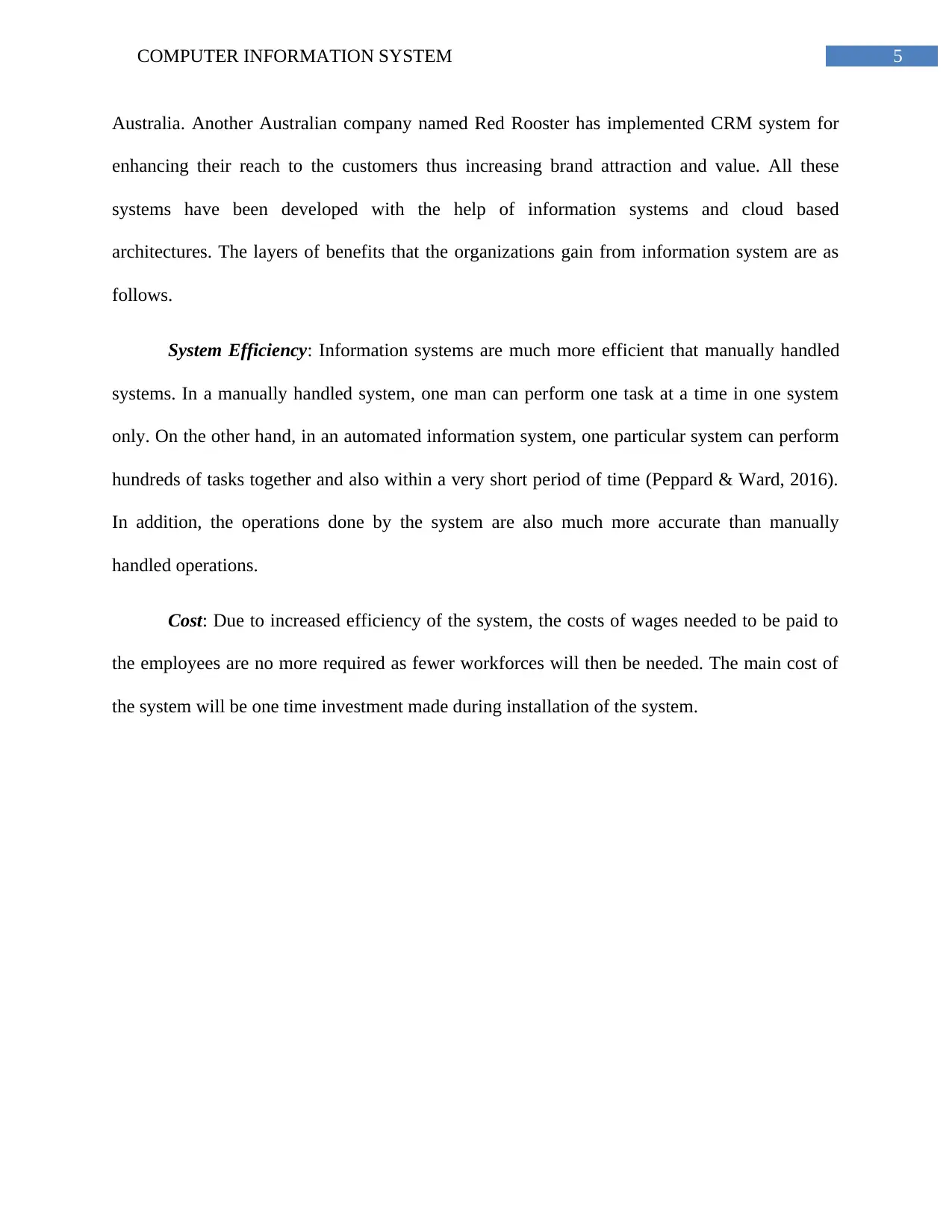
5COMPUTER INFORMATION SYSTEM
Australia. Another Australian company named Red Rooster has implemented CRM system for
enhancing their reach to the customers thus increasing brand attraction and value. All these
systems have been developed with the help of information systems and cloud based
architectures. The layers of benefits that the organizations gain from information system are as
follows.
System Efficiency: Information systems are much more efficient that manually handled
systems. In a manually handled system, one man can perform one task at a time in one system
only. On the other hand, in an automated information system, one particular system can perform
hundreds of tasks together and also within a very short period of time (Peppard & Ward, 2016).
In addition, the operations done by the system are also much more accurate than manually
handled operations.
Cost: Due to increased efficiency of the system, the costs of wages needed to be paid to
the employees are no more required as fewer workforces will then be needed. The main cost of
the system will be one time investment made during installation of the system.
Australia. Another Australian company named Red Rooster has implemented CRM system for
enhancing their reach to the customers thus increasing brand attraction and value. All these
systems have been developed with the help of information systems and cloud based
architectures. The layers of benefits that the organizations gain from information system are as
follows.
System Efficiency: Information systems are much more efficient that manually handled
systems. In a manually handled system, one man can perform one task at a time in one system
only. On the other hand, in an automated information system, one particular system can perform
hundreds of tasks together and also within a very short period of time (Peppard & Ward, 2016).
In addition, the operations done by the system are also much more accurate than manually
handled operations.
Cost: Due to increased efficiency of the system, the costs of wages needed to be paid to
the employees are no more required as fewer workforces will then be needed. The main cost of
the system will be one time investment made during installation of the system.
⊘ This is a preview!⊘
Do you want full access?
Subscribe today to unlock all pages.

Trusted by 1+ million students worldwide
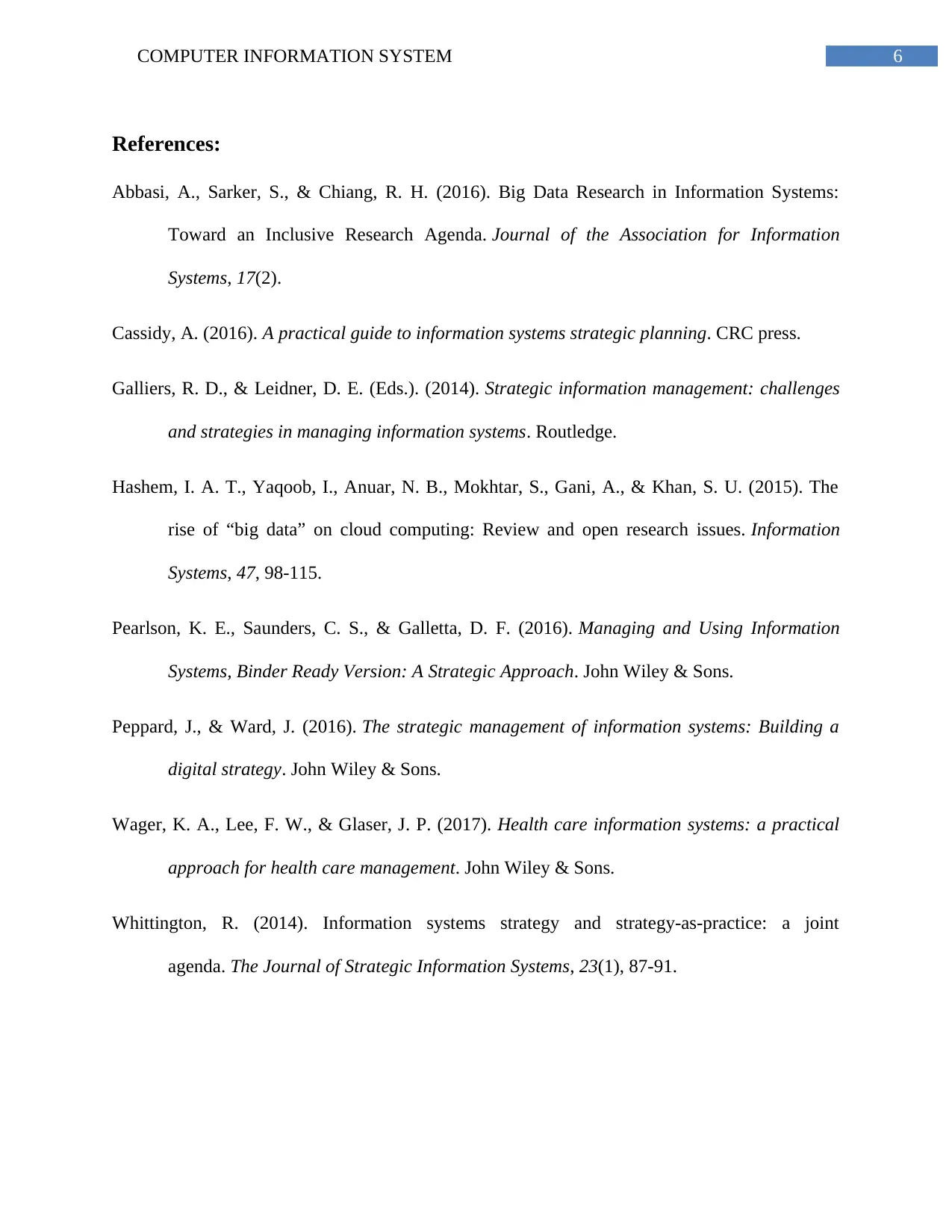
6COMPUTER INFORMATION SYSTEM
References:
Abbasi, A., Sarker, S., & Chiang, R. H. (2016). Big Data Research in Information Systems:
Toward an Inclusive Research Agenda. Journal of the Association for Information
Systems, 17(2).
Cassidy, A. (2016). A practical guide to information systems strategic planning. CRC press.
Galliers, R. D., & Leidner, D. E. (Eds.). (2014). Strategic information management: challenges
and strategies in managing information systems. Routledge.
Hashem, I. A. T., Yaqoob, I., Anuar, N. B., Mokhtar, S., Gani, A., & Khan, S. U. (2015). The
rise of “big data” on cloud computing: Review and open research issues. Information
Systems, 47, 98-115.
Pearlson, K. E., Saunders, C. S., & Galletta, D. F. (2016). Managing and Using Information
Systems, Binder Ready Version: A Strategic Approach. John Wiley & Sons.
Peppard, J., & Ward, J. (2016). The strategic management of information systems: Building a
digital strategy. John Wiley & Sons.
Wager, K. A., Lee, F. W., & Glaser, J. P. (2017). Health care information systems: a practical
approach for health care management. John Wiley & Sons.
Whittington, R. (2014). Information systems strategy and strategy-as-practice: a joint
agenda. The Journal of Strategic Information Systems, 23(1), 87-91.
References:
Abbasi, A., Sarker, S., & Chiang, R. H. (2016). Big Data Research in Information Systems:
Toward an Inclusive Research Agenda. Journal of the Association for Information
Systems, 17(2).
Cassidy, A. (2016). A practical guide to information systems strategic planning. CRC press.
Galliers, R. D., & Leidner, D. E. (Eds.). (2014). Strategic information management: challenges
and strategies in managing information systems. Routledge.
Hashem, I. A. T., Yaqoob, I., Anuar, N. B., Mokhtar, S., Gani, A., & Khan, S. U. (2015). The
rise of “big data” on cloud computing: Review and open research issues. Information
Systems, 47, 98-115.
Pearlson, K. E., Saunders, C. S., & Galletta, D. F. (2016). Managing and Using Information
Systems, Binder Ready Version: A Strategic Approach. John Wiley & Sons.
Peppard, J., & Ward, J. (2016). The strategic management of information systems: Building a
digital strategy. John Wiley & Sons.
Wager, K. A., Lee, F. W., & Glaser, J. P. (2017). Health care information systems: a practical
approach for health care management. John Wiley & Sons.
Whittington, R. (2014). Information systems strategy and strategy-as-practice: a joint
agenda. The Journal of Strategic Information Systems, 23(1), 87-91.
1 out of 7
Related Documents
Your All-in-One AI-Powered Toolkit for Academic Success.
+13062052269
info@desklib.com
Available 24*7 on WhatsApp / Email
![[object Object]](/_next/static/media/star-bottom.7253800d.svg)
Unlock your academic potential
Copyright © 2020–2025 A2Z Services. All Rights Reserved. Developed and managed by ZUCOL.




